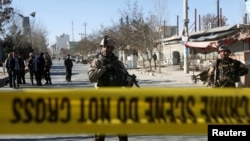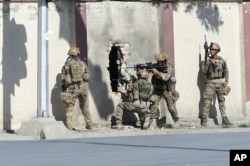Last year was the deadliest since 2016 for journalists in Afghanistan, with 21 reporters being killed in the line of duty, a new report, released by Nai, a nongovernmental organization advocating for open media in Afghanistan, claims.
Abdul Mujib Khelwatgar, the chief executive officer of Nai told reporters last week that his organization had registered 141 cases of violence against reporters across Afghanistan.
“Based on our new report, the Afghan government and those working in the government are responsible for 62 cases of violence against reporters, terror groups are responsible for 42 cases of violence, illegal armed groups are responsible for 26 case,” Khelwatgar said.
“Eleven cases involve violence by media sector employers,” Khelwatgar added.
In 2017, 23 reporters were wounded and 21 others physically assaulted in Afghanistan, Khelwatgar added.
Afghan judiciary criticized
Khelwatgar stressed that the Afghan government is not responsible for any of the killings.
“Taliban, ISIS and, in a few cases, unknown people are responsible for the killing of the media staff and journalists. The government of Afghanistan is not behind any of these killings,” Khelwatgar told VOA, using an acronym for the militant group Islamic State.
But he did criticize the country’s judiciary for only pursuing and investigating 43 cases of violence against reporters.
Journalists have increasingly come under attack by terror groups in Afghanistan in recent years.
On Dec. 28, a suicide attack on a compound housing the Afghan Voice news agency and Tebyan cultural center, killed at least 40 people and wounded dozens more. Several among those wounded were reporters.
The Islamic State terror group claimed responsibility for the attack.
In early November, gunmen disguised as Afghan national police attacked the headquarters of the privately owned Shamshad TV in the capital, Kabul, killing one staff member and injuring several others.
Islamic State claimed responsibility for that attack as well.
Following the attack, the United Nations Assistance Mission in Afghanistan said in a tweet that journalists are civilians who should not be targeted.
In May, IS fighters targeted the Afghan state television building in Nangarhar’s provincial capital, Jalalabad, killing six people.
Also that month, two media workers, including a driver for the British Broadcasting Corporation (BBC), were killed in the truck bomb attack on the German Embassy in Kabul. The offices of 1TV, another privately owned Afghan TV station, were also damaged.
IS also claimed responsibility for that attack.
2016 a deadly year
Before Nai’s recent report, the organization said 2016 was the deadliest year for reporters in Afghanistan since 2001.
“Prior to [2017], 2016 was the deadliest year for media staff and journalists ... in which 14 media staff were killed,” Khelwatgar said.
In January 2016, Taliban claimed responsibility for a suicide attack on a mini bus, carrying reporters working for Tolo television, the country’s most-watched television channel. Seven journalists were killed in that attack.
Following that attack, the insurgent group warned media organization in a statement to avoid promoting “obscenity,” “irreligiousness,” “foreign culture” and “nudity.”
Afghanistan remains one of the world’s most dangerous countries for journalists and media workers.
Afghanistan ranks 120th out of 180 countries on the Reporters Without Borders (RSF) Press Freedom Index.
“By sowing terror, the Taliban and Islamic State have created information ‘black holes’ in many regions since 2015,” RSF said on its website about the media environment in Afghanistan. “Afghanistan struggles to protect its journalists in this increasingly violent civil war.”
In addition to terror groups, government officials and Afghan security forces have also been accused of violence against journalists in the country.
“… Many governors and local officials are unable to accept the principle of media independence, and the police and military are implicated in several cases of violence against journalists,” RSF said.
Determination
Despite the security risks and danger, Afghan journalists seem determined to continue their work.
That determination was in full display in November when injured Parwaiz Safi, a journalist for Shamshad TV, in a sign of resilience appeared live on TV with news to his audience hours after the IS attack. His bandaged hands could be seen during the live broadcast.
The media sector in Afghanistan grew substantially following the fall of the Taliban. About three dozen TV stations reportedly operate in the country, and there are about 170 FM radio stations as well as hundreds of print media outlets.
The Afghan government has been citing the growth in the media sector as one of its achievements and vows that it will protect the media, but industry advocates are concerned that the government might be in the process of losing its grip on that achievement if it does not take the necessary steps to protect reporters from violence.
Khalid Mafton from Washington and Abdul Hai Warshan from Kabul contributed to this report.









